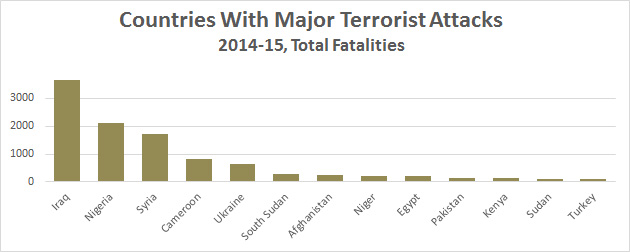What’s the evidence that President Trump’s immigration order is, despite his protestations, effectively meant to be a temporary ban on Muslims entering the country? Here’s the bill of particulars:
Article 1: In late 2015, Trump explicitly called for “a total and complete shutdown of Muslims entering the United States until our country’s representatives can figure out what is going on.”
Article 2: Trump subsequently tasked Rudy Giuliani with developing his immigration policy. On Saturday Giuliani told Fox News that “when he first announced it he said Muslim ban,” but Trump then called and said, “Put a commission together, show me the right way to do it legally.” This strongly suggests that Giuliani’s job was to find something that was effectively a Muslim ban without explicitly mentioning Muslims.
Article 3: According to Giuliani, the “right way to do it legally” was to focus on “areas of the world that create danger for us.” There are several plausible possibilities here. The most obvious one is to ban entry from residents of countries that have been designated as state sponsors of terrorism. However, that includes only three countries (Iran, Sudan, Syria). Alternatively, the State Department has a list of terrorist safe havens. But this includes places like Egypt, Pakistan, the Philippines, Colombia, Malaysia, and Lebanon, which the Trump administration apparently didn’t want to include. Another possibility is countries that have been the site of major terrorist attacks. However, according to the Global Terrorism Database, in 2014-15 this included several majority-Christian countries (Nigeria, Ukraine, Kenya), several US allies (Egypt, Turkey, Pakistan) and excluded several countries that Trump has specifically called out (Iran, Libya).

After exhausting these obvious possibilities, Giuliani’s team finally dug up the far-from-obvious list of places that have been designated as “countries of concern” under the Visa Waiver Act. Conveniently, this includes seven countries that are collectively 97 percent Muslim, but none of which are sensitive US allies.
Article 4: Nobody from the seven countries covered by the VWA has been responsible for any terrorist fatalities in the United States. Conversely, residents and former residents of several countries not on the list (Saudi Arabia, Pakistan, Russia) have been responsible for fatal terrorist attacks, yet they’re not included in the entry ban.
Article 5: According to news reports, the immigration order was written with no interagency review, and without the input of either counterterrorism officials or the Office of Legal Counsel. Administration officials couldn’t even agree on simple things like whether it applied to green card holders, and immigration officials around the country were left with almost no guidance about how to apply the order. All this suggests an effort to hastily produce a policy that reflected Trump’s wishes for a “Muslim ban” rather than something that makes sense.
Article 6: A day after his policy went into effect, Trump himself made it clear that he continued to be obsessed with Christians as victims of terrorism:
Christians in the Middle-East have been executed in large numbers. We cannot allow this horror to continue!
— Donald J. Trump (@realDonaldTrump) January 29, 2017
Legally, I doubt that this is enough. I Am Not A Lawyer™, but I gather that courts don’t generally take account of arguments that rely on evidence of hidden intent unless there’s truly a smoking gun. The text of the executive order carries most of the weight, and the president has extremely broad authority in immigration law. Most likely, the bulk of Trump’s order will remain in effect.
In the court of public opinion, however, the evidence suggests pretty strongly that Trump’s order was, in fact, little more than a thinly disguised attempt to ban Muslims from the Middle East—except for those from a few favored allies. Pretzel-bending arguments aside, it’s really pretty obvious what’s going on here.















